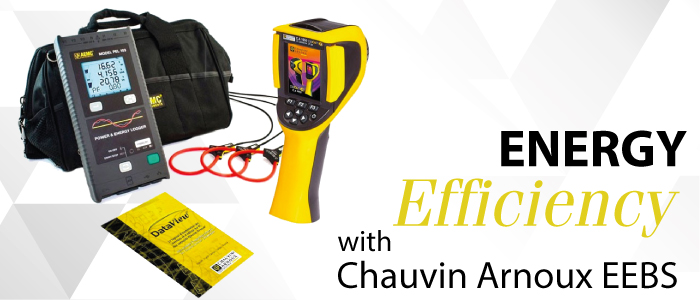
Amid rising energy prices and an uncertain trading environment, energy efficiency - the so-called ‘fifth-fuel’ - is becoming an evermore important factor in decisions made by business owners and managers. In fact, Carbon Trust research has shown that up to 20% of energy costs are spent on unnecessary or wasted energy so the potential saving is very significant. Luckily, Chauvin Arnoux has provided a comprehensive solution to identifying inefficiencies and waste: the Energy Efficiency Business Solution (EEBS) - available right now from Test-Meter - which features a power quality analyser and thermal camera for picking up on both electrical and thermal wastage.
Chauvin Arnoux PEL103 Power Quality Analyser
Two of the three main issues leading to energy inefficiency are out-of-hours use and inefficient electrical equipment. Small businesses regularly spend up to 46% of energy costs on out-of-hours usage so the potential savings are massive. These areas can be easily identified using the Chauvin Arnoux PEL103 Power Quality Analyser, the first main component of the EEBS package. The analyser is easy to install thanks to its integrated magnets and measures a wide array of electrical variables in order to provide a comprehensive picture of electricity consumption throughout a system. In particular, power factor highlights energy that is not being used and the instrument can even monitor harmonics up to the 50th order which is great for plants with lots of machinery. The quality of power supply can also be assessed with the PEL103 to help diagnose issues and waste. Measurement capabilities are further enhanced by three provided MA193 MiniFlex Clamps which can measure AC current up to 10kA. It can be left in place for extended periods of time and connects to a network via an Ethernet cable so it can be remotely monitored for easy use. As a portable instrument, the PEL103 also offers the opportunity to monitor one particular machine or a whole circuit at the user’s discretion. Overall, it is a great instrument for identifying regular consumption patterns, usage spikes and anomalous or unusual electricity use.
Chauvin Arnoux 1950 Diacam2 Thermal Camera
The second main instrument in the EEBS package is the Chauvin Arnoux 1950 Diacam2 Thermal Camera. This is ideal for assessing waste caused by thermal leakage, the third major source of energy inefficiency, as well as finding inefficiency caused by faulty components. Both poor insulation and flue loss contribute to a rise in inefficiency of up to 70%. A clear thermal image is provided by the camera’s 80 x 80 pixel thermal sensor which features <80mK thermal sensitivity and a temperature range of -20˚C to 250˚C. These thermal capabilities can help spot poor insulation in buildings as well as malfunctioning machinery that is running hot and wasting energy. A Bluetooth® headset allows the user to add a personal commentary to saved files and CAMReport software can be used to create quick reports on findings. A digital camera is included and saves normal images alongside thermographs for easy analysis whilst the 13-hour battery life is perfect for carrying out extensive inspections over large sites.
Chauvin Arnoux DataView® Software
The third and final main constituent of the EEBS package is the Chauvin Arnoux DataView® software. This user-friendly software for PC helps the user transfer data across from both instruments and then perform comprehensive analysis in order to identify the exact cause of high energy consumption before moulding findings into a clear, concise report.
Overall, the Chauvin Arnoux EEBS can help identify potential savings in terms of both electrical consumption and thermal efficiency. This can take the form of anything from a malfunctioning motor drive to poorly insulated piping so the package allows truly comprehensive assessment. The datalogging capability of each instrument and the analysis functions of the software provided help record all findings and make accurate, insightful reports. These capabilities are useful whether you are running a small business particularly vulnerable to energy inefficiency, a large business which must comply with the Energy Savings Opportunity Scheme (ESOS), or are looking to provide energy efficiency services to others.
